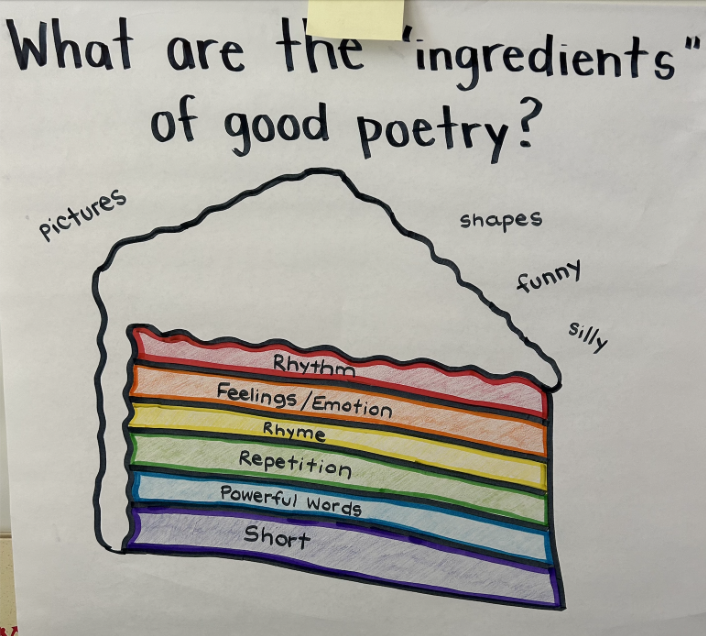In Our Own Words: Using Poetry to Explore Identity in First Grade
Project Beginnings
At Lowell, a progressive independent school in Washington, DC, explorations of identity are central to our work. First graders have historically started the year with a unit focused on the myriad pieces of their identity, from their family structure to skin color; their traditions to their gender identity. After coming across the Poetry of Us project on the ECPBL website, we decided to take a new lens to our identity work by creating identity-based poetry. While the project was originally implemented with younger students, we were able to utilize the milestones, as well as many of the resources, as inspiration.
Driving Question
Our driving question for the unit was, How can we write poetry to celebrate who we are? Students were tasked with creating a book of poetry that explored various facets of their identity and included both individual and collaborative poems. They also learned that they would be presenting their individual poems aloud as part of a poetry reading at a local bookstore.
To begin, first graders engaged in an exploration of poetry as a form of writing. They read and discussed a variety of poems and practiced looking with a “poet’s eyes” at everyday objects. We created a list of poetry “ingredients”—things like rhyme, rhythm, and repetition—that are often found in poetry. We experimented with these ingredients, as well as various types of poems. We even had a visit from a professional poet!
Once we had a handle on poetry, we began a deep dive into identity. Through read-alouds and conversation, students explored several pieces of identity: gender identity and expression, skin color, hair and eyes, family structure, likes and dislikes, traditions, and languages. Throughout the milestone, first graders kept an identity map to track their learning, adding words or images to represent each new piece of their identity. This identity map became both a valuable reference later in the unit and a way for students to connect with one another by noticing similarities and differences among their peers.
Finally, first graders were ready to put these two areas of learning together by creating identity poetry. Once again, they explored various formats and types of poems, while also considering which pieces of their identity they most wanted to share. With a few poems under their belt, they chose a favorite to edit and share in our poetry book and aloud at the poetry reading. We engaged in small group revision and critique using a rubric the students had worked together to create. First graders also worked in small groups to craft collaborative poems on a particular identifier.
As a class, we created a rubric to encapsulate the most important features of a poem. Students were independently able to reference the rubric as they wrote.
Samples of small group collaborative poems. Students were placed into small groups based on an identifier of their choice, then crafted a poem focused on that identifier with their group mates.
Samples of individual poems, one following an “I Am” template and one written as a sensory poem.
For our final milestone, first graders created identity art to accompany their poetry. We chose to make identity maps, with each child tracing their hand and filling it with images and words to represent their various identifiers. These colorful creations were published alongside a painted self-portrait and the final individual poems.
Samples of student artwork, including painted self-portraits
Making It Public
In early November, first grade families were invited to a local bookstore for a poetry reading and book release party. The bookstore, located in nearby Takoma Park, Maryland, is owned by a former educator who was thrilled with the idea of hosting our students and their families. Each child had a chance to read aloud their individual identity poem to a packed room. Families were also given a hard copy of the completed poetry books, showcasing the students’ learning and hard work. The children brimmed with excitement and the pride from the families was evident.
Our final poetry book, which was distributed at the poetry reading, featured a cover of miniature self-portraits by each first grader.
Final Thoughts
Poetry provided a novel lens for the exploration of identity, and reinvigorated this unit—and us!—in delightful ways. Young children are natural poets, seeing the world with fresh and playful eyes. They are also naturally inquisitive about themselves and others. It makes perfect sense, then, that they easily joined these two ideas together. When given the necessary poetry tools, as well as the language to explore and share about themselves, they thrived. The poetry reading and the accompanying book provided a powerful source of motivation and noticeably deepened student engagement. We are looking forward to continuing to build this unit with our young poets in the year to come.
Julie Bowes, Samantha O’Brien, Jane Yang, and Libby Niedland are first grade teachers at Lowell School in Washington, DC with a collective 42 years of teaching experience. They love first graders for their endless curiosity and unmatched enthusiasm.







